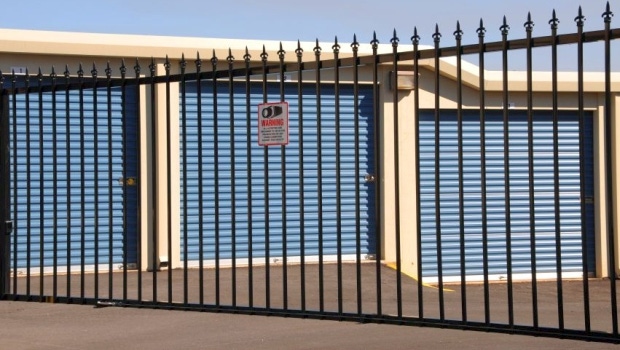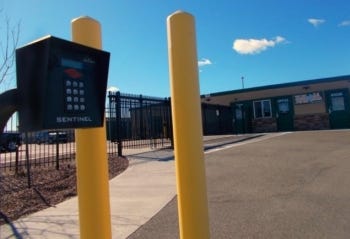Fortifying a Self-Storage Facility for Security and Marketability
Securing a modern day self-storage development warrants thoughtful planning and execution. Learn how to create a proper security strategy for a successfully fortified and marketable site.

Securing a modern day self-storage development warrants thoughtful planning and execution. Today’s projects are more diverse than ever before. Properties require a combination of standard and custom-designed security components and practices. A proper strategy is essential to create a successfully secured and marketable site. Technology and components are ever-changing, so your security philosophy should be, too.
Site Plan and Access
From start to finish, security should play a role in the design and construction of your self-storage project. The first component to consider is your site plan. Before setting the building layout, establish the position of the gate in relation to the office. In a traditional storage property, the gate location is the single most important consideration in regard to security. When possible, create sight lines so you can see the storage units from the office, as this will discourage would-be thieves.
Of course, multi-story, climate-controlled storage presents a different set of circumstances. Instead of a gate, main access doors are usually placed near the office. Other entry points will need access-control devices to limit entry and exit to only those who are authorized. Hallways will require more cameras, too. These added components can drive up your security budget, so be prepared.
Traditional access control for self-storage properties generally includes keypads. Although other, more sophisticated technology is available, keypads are still the preferred tool at the majority of facilities. Thousands of properties are using these machines, which means they won’t go away any time soon. Owners aren’t likely to scrap functional systems.
 Keypad wiring and installation is simple and straightforward, and there have been many enhancements added through the years. Keypads now have “onboard brains”; if communication with the software fails, the keypad houses the access codes for continued operation. Intercoms can be housed in the keypad as well as pinhole cameras, which may be connected to a video-recording system. Communication with the keypad can now be accomplished via the Internet, eliminating the need for a computer at unattended sites.
Keypad wiring and installation is simple and straightforward, and there have been many enhancements added through the years. Keypads now have “onboard brains”; if communication with the software fails, the keypad houses the access codes for continued operation. Intercoms can be housed in the keypad as well as pinhole cameras, which may be connected to a video-recording system. Communication with the keypad can now be accomplished via the Internet, eliminating the need for a computer at unattended sites.
New technology is adding to the way customers access properties, and specialty types of storage drive the need for different access-control components. Proximity or card readers make sense in applications where state-of-the-art security is desired. These might include multi-story buildings, or properties that offer storage for boats, RVs, classic cars, art or wine. These readers can be used with cards, key fobs or clickers. Smartphones can be used as proximity devices, and applications are being written to use them as a wireless keypad.
Door Alarms
The self-storage security system that ends with the access gate or door welcomes the would-be thief. Picture this scenario: A person rents a unit and is given an access code. He begins spending time on site, observing activity and what’s inside any open units. All the while, he’s making a mental and physical inventory, planning what to steal later. When the opportunity presents itself, he cuts the locks on select units and takes the goods, storing them in his own unit or moving them to the front of the original unit for later loading into a truck. He puts a lock back on each unit so no one is suspicious until a tenant comes in and can’t open his space.
Individual door alarms eliminate this risk. As soon as the thief opens the first door that doesn’t belong to him, an alarm sounds and the office or monitoring company is notified. The burglar has no choice but to rent at a facility where alarms haven’t been installed.
Wired door alarms consist of a switch, wire, multiplexer, communication module with power supply, relay module, siren, and software. The switch reads the status of the latch (open or closed). It wires back to a multiplexer, which poles the status of each door connected to it. A single communication cable from the series of multiplexers to the communication module, and then a USB cable to the computer with software, complete the path of intelligence. A relay module connects to a separate USB on the computer to drive a siren or annunciation in the case of an alarm situation.
Wireless door alarms consist of a switch with transmitter and battery, receiver, communication module, and software. They’re not reliable or practical for a self-storage application as battery performance and longevity are affected by the cold. Other signals in the area can affect the signal at the site. Concrete and steel construction can also have an adverse affect on their overall reliability.
Video Cameras
Video cameras continue to evolve with better picture quality, recording capability and accessibility. If you’re constructing a new site, you’ll benefit from using current technology. An existing site may need to consider updating the present equipment.
Digital cameras are taking the place of analog. Internet-protocol (IP) systems can send and receive data through a computer network and the Internet, and provide enhanced picture quality. If you’re replacing analog cameras, you’ll also need to replace the video recorder to take advantage of the better quality picture in the recording phase. You should also consider upgrading your monitor quality.
High-definition cameras are another option for better resolution without going with an IP solution. You’ll need to replace the other components of the system, including monitors, recorders and power supplies. The good news is with new recorders, you’ll be able to view camera activity remotely through a smartphone, tablet or any computer with Internet access.
Installation
The right installer can make or break your ability to secure your self-storage facility. It can mean the difference between a smooth running operation and an ongoing maintenance issue. Your installer will know the latest safety-device requirements for your gate and access controls.
Keep in mind that your best choice for an installer may not be the closest geographically or the least expensive. A great installer will provide valuable input. Make yourself available, and ask the company to be accessible to you in case you have questions or concerns later.
Evaluation
Revisit your security system every five years to evaluate the features and quality. Technology and components can become outdated quickly. Providers consistently refine their products, adding in or redesigning for enhancements in functionality and performance. Rotating new components in at different intervals will help minimize the cost.
Just be careful not to sacrifice aspects of your security strategy because you haven’t budgeted for ongoing expenditures. Your system can help you attract new renters, protect customers’ belongings and discourage potential wrongdoers. Your tenants will have peace of mind that their stored goods are safe, while you and your staff will be proud to provide a quality product and rental experience.
John Fogg is the general manager of Sentinel Systems Corp. He has worked in self-storage since 1986. Sentinel provides WinSen property-management software and security-access systems, individual door alarms, wireless door alarms, and more. The company celebrated its 40th anniversary in 2015. For more information, call 800.456.9955, ext. 405, e-mail: [email protected]; visit www.sentinelsystems.com.
About the Author(s)
You May Also Like





